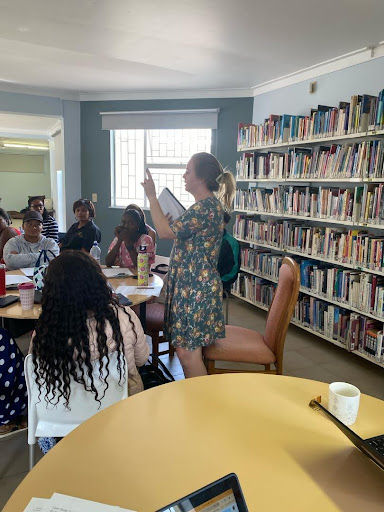Social Media - a blessing or a curse?
- Windhoek International School
- Feb 2, 2024
- 4 min read

This past week, the school was confronted with handling a situation in our middle school that originated from a TikTok trend that students had experimented with during a field trip. We are fortunate that all our students came away from this unharmed and we hope that they have learnt from the experience and take better care when imitating social media activities.
This has, however, brought the realisation, of how powerful social media has become and how its impact is already visible in pre-teen years. This made us reflect on the way we educate our children and ensure their safety. Developments are so rapid that it is hard to keep abreast with things that appear all the time.
What we as educators - the school and parents together - have to aim to do is to focus on character education more than controlling our children’s behaviour. If we can build strong characters, we will be able to have our kids make choices and decisions that are thoughtful and safe and will make them responsible citizens and young people who can make a difference in their communities and for our planet.
Being connected has many benefits for young people. If social media are used responsibly and in the younger years with strict adult supervision, then it can contribute to our children’s creativity, learning, interests, and hobbies.
Social media: benefits
“Social media is a big part of social and creative life for pre-teens and teenagers.
Pre-teens and teenagers use social media to have fun, make and maintain friendships, share and learn interests, explore identities and develop relationships with family. It’s an extension of their offline and face-to-face interactions. For older teenagers especially, it’s often a key part of how they connect with friends.
Social media can connect pre-teens and teenagers to online global groups based on shared interests. These might be support networks – for example, for young people with disability or medical conditions, LGBTIQ+ teenagers, or children from particular cultural backgrounds. Or they might be sites for commenting on and sharing content about particular interests like games, TV series, music or hobbies.
Your child can get many other benefits from using social media:
Learning: your child can use social media to better understand, extend or share what they’re learning at school, either informally or in formal school settings.
Hobbies and interests: your child can use social media to follow their interests and learn new ones.
Creativity: your child can be creative with profile pages, images, videos and game modifications.
Mental health and wellbeing: connecting with extended family and friends and taking part in local and global online groups can give your child a sense of belonging. (raisingchilden.net.au)
There does, however, need to be strict supervision in these young years and there need to be conversations about the risks and dangers of social media. Not making the time and effort for these two critical aspects of social media use and interaction will result in social media being used irresponsibly and have a negative impact on your child’s mental well-being, health, learning, hobbies and interests, and creativity.
Social media: risks
“Social media can also pose risks. For your child, these risks include:
being exposed to inappropriate or upsetting content, like mean aggressive, violent or sexual comments or images
uploading inappropriate content, like embarrassing or provocative photos or videos of themselves or others
sharing personal information with strangers – for example, images, date of birth, location or address
being exposed to too much-targeted advertising and marketing
being exposed to data breaches, like having their data sold on to other organisations. (raisingchilden.net.au)
This past week, we spent many hours talking to children with their parents and working to understand the behaviours that can potentially be quite dangerous and lethal. A trend on TikTok - Chroming - was introduced to some of our 11-year-old children.
The word ‘chroming’ is an informal word that originates from Australia. It refers to the act of inhaling the fumes from a toxic source, such as an aerosol can, a spray deodorant, or a paint container.
Spending time to learn about these trends and activities on social media can help us adults and educators - parents and the school - to be more aware and more vigilant in identifying and addressing potentially harmful behaviours.
One aspect of our students/children’s character development that we need to intentionally focus on is the notion of “pack mentality”, “being cool”, and “being a bystander” - not standing up for what you know is right. Addressing this mentality alone can ensure that our children make choices that are healthy and safe and in the interest of their community, their school and their family's well-being. Now more than ever, with so many temptations and impulses out there, it is the character of a person, that will have to be well-formed and grounded to make our young generation make use of technology and social media in a way that benefits them.
Top 10 Social Media Platforms Compared
MAU* | Revenue U$ | Launched | Headquarters | ||
1 | 3 billion | Not specified | 2004 | Menlo Park, CA | |
2 | YouTube | 2.5 billion | 29.24 billion | 2005 | San Bruno, California |
3 | 2 billion | Not specified | 2010 | Menlo Park, CA | |
4 | TikTok | 1.2 billion | Unknown | 2016 | Culver City, CA |
5 | Snapchat | 750 million | 4.6 billion | 2011 | Los Angeles, CA |
6 | X (Twitter) | 541 million | 4.4 billion | 2003 | Mountain View, CA |
7 | 465 million | 2.8 billion | 2005 | San Francisco, CA | |
8 | 430 million | 400 million | 2010 | San Francisco, CA | |
9 | く350 million | 12.4 billion | 2006 | San Francisco, CA | |
10 | Threads | 100 million | Unknown | 2023 | Menlo Park, CA |
*Number of monthly active users worldwide, updated October 2023.
Maggie Reiff
Secondary Principal








Comments